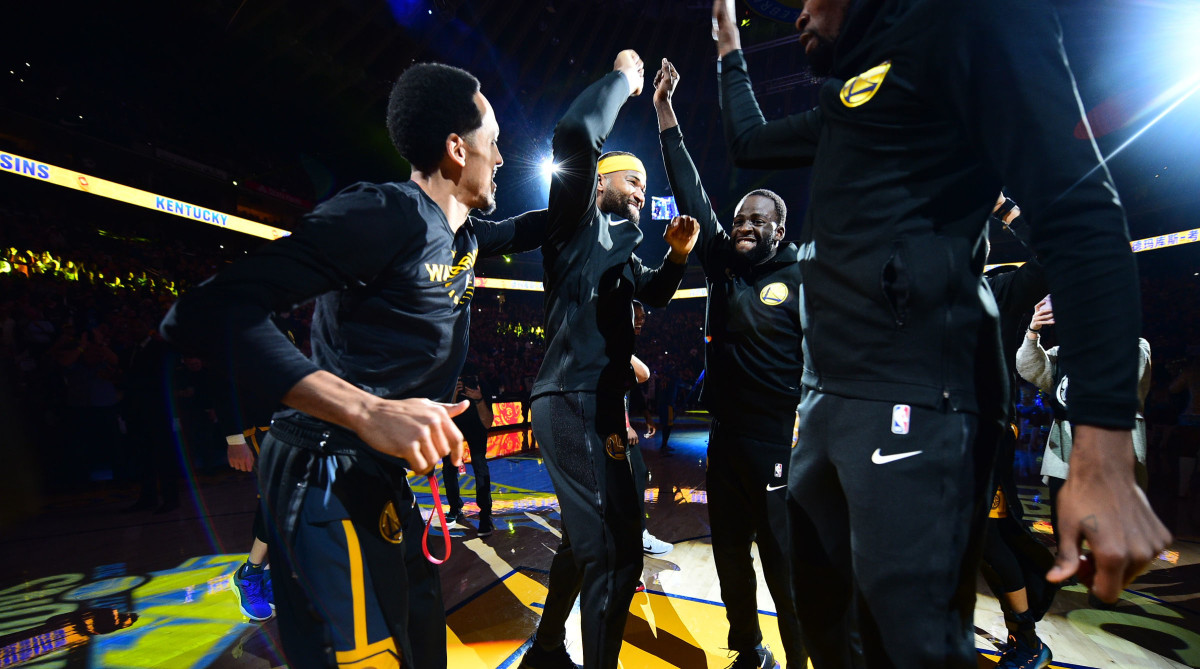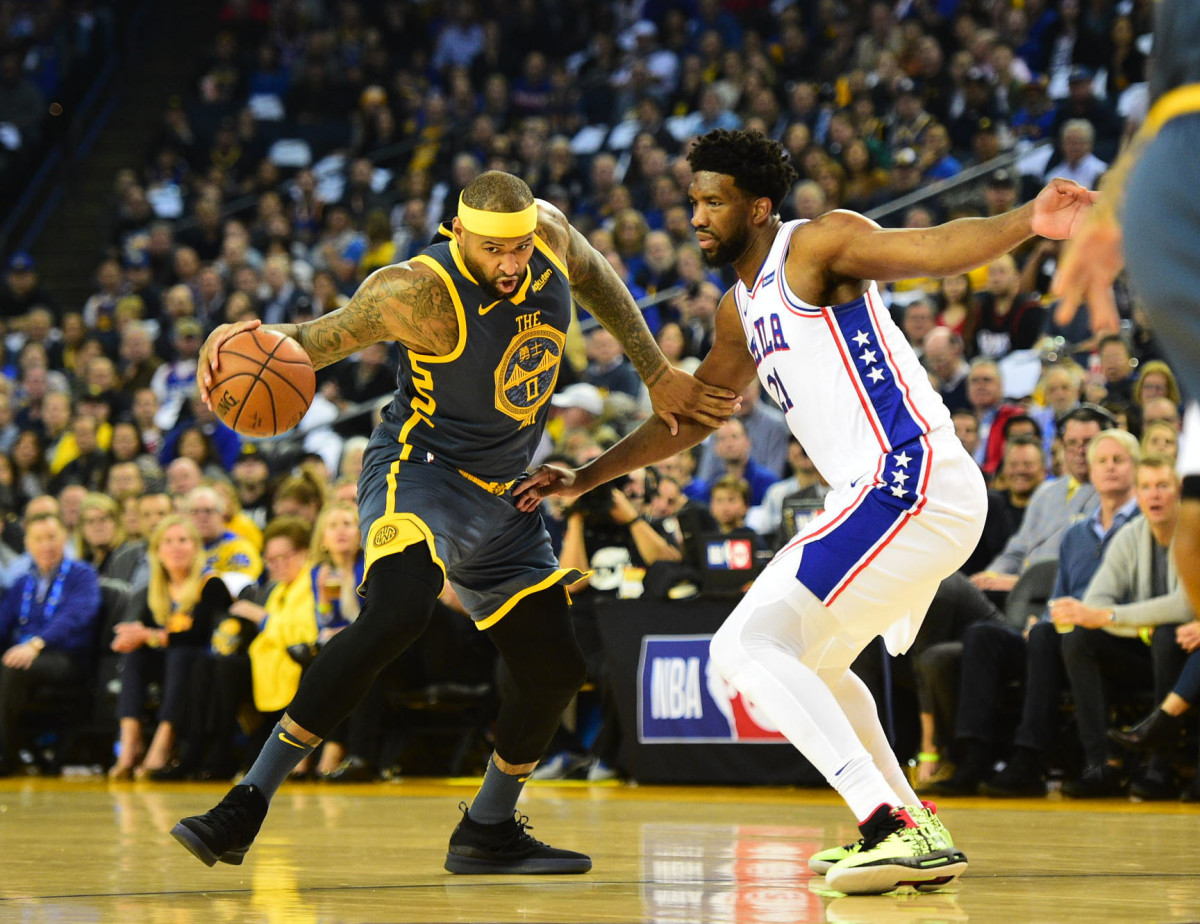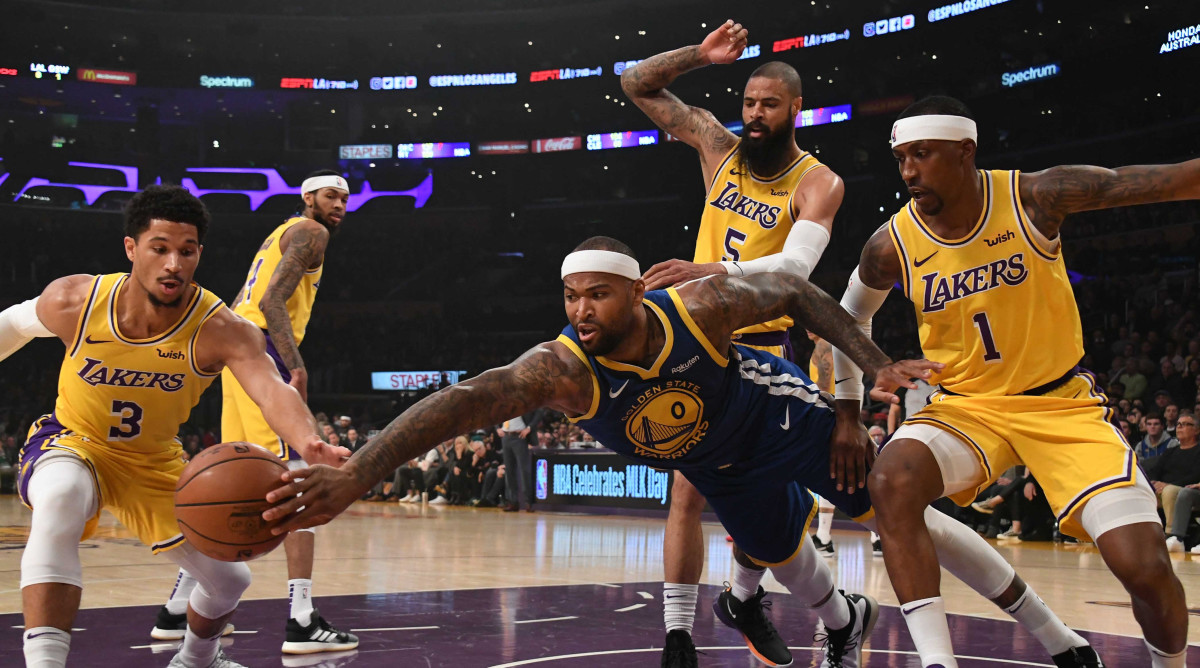The New Normal for DeMarcus Cousins and the Warriors

This story appears in the Feb. 11, 2019, issue of Sports Illustrated. For more great storytelling and in-depth analysis, subscribe to the magazine—and get up to 94% off the cover price. Click here for more.
In the dead of winter, most of the NBA is focused on next summer. Will Kevin Durant leave Golden State? Will Kyrie Irving follow him? Where will Anthony Davis be? The league spent the week of the trade deadline consumed by competing superstar agendas, strategic media leaks, cap space, conspiracy theories and hypothetical superteams. It's a meta-game that is great and strange and addictive. It also may be the only game that anyone outside the Bay Area has any real chance to win this year.
Above the fray of deadline madness, DeMarcus "Boogie" Cousins is healthy now, and the distance between the Warriors and the rest of the NBA has only gotten wider. “The first time we went through a shootaround,” says 33-year-old guard Shaun Livingston, “we do our [new] starting five, and I’m like, ‘Holy s---. This is crazy.’ I had the same feeling when KD got here. Then that kind of wore off, and it became normal. Then Cousins got here.”
Consider Cousins the richest man’s Zaza Pachulia. Also, for any Western Conference rivals, consider this a trigger warning.
Golden State now starts five players who were part of last year's All-Star Game. Draymond Green says that integrating Cousins is a challenge for a team that’s never had a traditional low-post threat, but after three titles in four years, new challenges can be helpful. “If you’ve watched the last couple of games, there’s been a few plays where maybe some guys come off without a shot because they’re looking for DeMarcus,” says Green. “With time, we’ll just play. But I like to see that. It shows that it matters. To get another guy going, to get him feeling like he fits.”
Once upon a time, this Warriors season was full of uncertainty, tension and complacency. At the lowest points, various outsiders wondered if we were watching the '04 Lakers for a new generation. But as Durant said before a game in late January, some of those concerns were overblown: “Just because we lose a few games don’t mean that, like, s--- is over for us. It’s like any team. You go through stretches. But, you know, add another All-Star to the equation, things change up.”
Fully recovered from a left Achilles-tendon injury, Cousins is now 9–1 as a Warrior. But it’s more than just Boogie. Golden State has won 15 of 16 overall, and since a pair of losses around Christmas, the Warriors are 17-2, with wins coming by an average of 17 points per game. “It’s been the first sustained run of health we’ve had since the beginning of the season,” says coach Steve Kerr, “and I think it shows.”
Stephen Curry, who missed three weeks with a groin injury, is fully healthy again and shooting an obscene 44.8% on 11.5 three-point attempts per game. Durant has played every game this season, and he’s putting up a casual 27.3 points, 7.1 rebounds and 6.0 assists, on 50.5% shooting. Klay Thompson remains one of the most lethal secondary options in the league, and about once a month he'll have an out-of-body shooting night that stops the entire league. Green looks like a nightly triple-double threat again. In general, the past month has been an emphatic response to anyone who might have been foolish enough to think the rest of the NBA had a chance.
But the most interesting thing about this Warriors season is that even as Cousins arrives and the team gets rolling, some of the tensions are still here. This summer’s uncertainty hasn’t been resolved. The vibes can still be a little strange. Night to night motivation is tricky. And at least for the moment, these players are so smart and so skilled that most of those concerns have been rendered irrelevant. "If he came back a month ago," Draymond says of Cousins, "he'd probably be screwed. We just weren't in a good place."

"Draymond would be the first to tell you he was not playing at an All-Star level the first couple months,” Kerr said before a recent game. It may be surprising to see any coach to discuss All-Star candidacy so honestly, but Kerr's candor was also a simple concession to reality. No one could have pretended that Green—who wasn’t selected for the game—looked like one of the best players in the league for most of this season. He was battling a toe injury, he wasn’t shooting the ball well, and he was spraying turnovers all over the floor.
As that story has changed, so has Golden State’s. “Draymond’s assist-to-turnover ratio,” Kerr says of the difference in recent weeks. “That tells the story. We’ve got guys who make plays, DeMarcus coming back giving us this huge boost. Klay going nuts. Steph going nuts. Kevin showing why he’s the best scorer in the world. [But] what Draymond’s doing is changing the game. We’re getting into our offense, he’s pushing the ball relentlessly, without making any turnovers.”
Green is healthier now than he has been in 18 months, and, as he's gotten more comfortable, he's stopped forcing things. Over his last 14 games, he has 120 assists and just 26 turnovers. “I never doubted [Green],” Durant says. “It only got reckless with everybody else out there. We all have stretches where you don’t play particularly well. But it’s an 82-game season.”
Of course, on-court issues were only half the story. On Nov. 12, after an OT loss to the Clippers, Durant was upset that Green didn’t pass him the ball at the end of regulation. They argued on the sideline, and the dispute became even more heated in the locker room. Durant’s impending free agency has loomed over this team’s future since last July, and that night in Los Angeles, Green snapped. Profanities were shouted. Details were leaked throughout the media. Relationships were jeopardized. The Warriors lost six of their next 10 games.
A team meeting eventually cleared the air. “We had to say, ‘Look, this is an opportunity for us to grow,’ ” says Livingston. “We’ve won championships. We obviously have the talent. But have we gotten over something like this before? Nobody had all the answers. None of us are therapists. But just to have an honest conversation and honest dialogue—then we can shed some of this stuff and just go play.” No one has revealed what was said. “That’s personal,” Durant says of his relationship with Green. “But how we doing on the basketball court? That’s the only thing that matters, right?”

In the middle of all this, now there's Boogie. Everyone on the team likes him, and after his injury last January cost the four-time All-Star a nine-figure free-agent deal over the summer, everyone is rooting for him. He’ll look for a bigger contract again this summer, but after signing a one-year, $5.3 million deal, he’s on the Warriors through at least July. He has a variety of skills that can help, but to begin with, the 6'11", 270-pound Alabama native can lighten the mood around this team. Sometimes that happens when he’s asked how he might keep his fouls down. (“I don’t know. I’m gonna have to start taking these [refs] out to dinner.”) Other times it’s when he’s wading through a sea of 20 or 30 reporters and looking for Raymond Ridder, Golden State’s 5'6" VP of communications: “Raymond! Where’s your little ass at?”
After one practice Cousins and Durant played one-on-one, exchanging trash talk and foul allegations the entire time. When KD hit a step-back three and walked off, declaring victory, he saw two grade-schoolers watching on the side. “Go double-team him,” Durant said. Only one of the boys stepped forward, but Cousins passed him the ball—then swatted his layup attempt 20 feet from the hoop. Cousins scowled for a few seconds after the block, but he couldn’t keep a straight face. He missed his next shot on purpose and made sure the boy could poke the ball away. On the next play, the boy dribbled through Boogie’s legs for a game-ending layup that had the whole gym cheering.
In real games, against NBA players, the 28-year-old Cousins is ahead of schedule. He’s moving well on defense, his gifts as a passer and shooter make him an ideal fit with the offense, and per 36 minutes, he’s averaged 23.9 points, 11.0 rebounds, and 6.0 assists. There were some fears that Cousins could disrupt the flow offensively or perhaps he wouldn't be 100% healthy, but so far, he's exceeded expectations. “I think DeMarcus was holding back in our scrimmages,” Kerr laughs. “He’s got a different level that he’s gotten to [in games].”
The Warriors don’t necessarily need more firepower, and the most dominant perimeter offense the league has ever seen could probably survive without a threat on the block. Given the success Golden State has had with 6'6" Andre Iguodala finishing games in place of a center, it’s still not clear how often Cousins will close. “We talked to him about that before we even signed him,” Kerr says. “We’ve got a bunch of talent. Every night’s going to be a little different.” What Cousins can definitely do, though, is serve as the hub of the second unit with Thompson, Green, Iguodala and Livingston. That group that might be good enough to make the playoffs on its own, and bench players around the NBA can only so much. In limited minutes with Cousins thus far, that second unit has a net rating of +23.1. “He’s a great screen-setter and a great passer,” Thompson said after one practice. “Last game he set us up for about four threes, just off handoffs. He knows how to use his body.”
Says Cousins, “That’s something I watched while I was on the sidelines. Like, how can I make the guys’ job easier? It’s a team full of high IQs. You put a team of high IQs together, it’s easy to get on the same page and play the right way. Not saying that it’s perfect, but it’s working out a lot smoother and easier than I guess a lot of people expected.”
There’s a popular misconception that the Warriors signed Cousins and took advantage of an opportunity that was available to the entire league. That’s only half true. Coming off last year's injury, Cousins was a risk. The track record for big men recovering from Achilles tears is not great. (Elton Brand, the closest parallel, ruptured his as a 28-year-old in 2007 and was never the same.) Cap space around the league was scarce, and it was clear that Cousins wouldn’t play until December or January. In the end, only a few franchises could even consider gambling on a player who was guaranteed to miss half the season. Only one of those franchises could offer Cousins the chance to join a perennial Finals team.
Now that Cousins is healthy, the story of his arrival has provided a welcome departure from a half-season’s worth of scrutiny. And the healthier he becomes, the more untouchable Golden State will seem. "Obviously we've got a long way to go," Green says, "and we know we have to continue to get better. [But] as far as integrating DeMarcus, it's been pretty seamless. It's not going to always be that way. There are going to be challenges that come along with it. But you try to get better each and every time you're on the floor, and then you get this feeling like, 'Alright, we're there.' And you get to clicking. We've been clicking pretty well."
There are still varying levels of unease elsewhere. Beyond everything that happened in November, there’s still occasional tension between running an offense built on ball movement and threes (as Steph said after a win over the Celtics: “That’s when we’re at our best; when everybody’s a threat, we’re moving the ball, looking for open shots”) and the iso-heavy approach that Durant seems to prefer (as Kerr said after that same Boston game: “[KD] is the one guy who can create an advantage out of nothing. When he does that, that’s when we’re at our best”). Meanwhile, Thompson is a free agent who will command a max contract this summer. Green will be looking for his own max deal in 2020, right after he turns 30. And KD really could leave in July. The Knicks cleared nearly $75 million in cap space when they traded Kristaps Porzingis to the Mavericks on Feb. 1, and Durant has been linked to New York since last June. The Clippers, among others, will be pursuing him too.
If there was one truth laid bare when Golden State was struggling this season, it’s that a Durant departure this summer could change everything. On the way into a new arena and a new era in San Francisco, the team lacks most of the depth it had when it was chasing titles in 2015 and ’16. Elite role players like Livingston and Iguodala have gotten older, while various young players haven’t developed as quickly as the team hoped. All of which is to say, as great as the Warriors should look for the next four months, owning the league a year from now is an entirely different conversation.

Before a game in Washington, Steve Kerr remembered his first year as coach, when the team celebrated winning a Pacific Division title in Portland. There were t-shirts and hats made. They took a photo to celebrate. And as Kerr said, "The thought of these guys celebrating a division title, now, is laughable." Back then, Draymond added, "Steph was still trying to get himself established. Klay was still trying to get himself established."
Four years is a long time. The night before a game at Washington, Curry had hosted a Howard University screening of a documentary exploring the Dylann Roof murders in South Carolina, a film he executive produced through his new production company. Durant attended a ceremony to celebrate the opening of an after-school center that his charity will be funding in his hometown of Seat Pleasant, Md. The next morning, the entire team met with Barack Obama, a gathering arranged by Curry. After the game, Nancy Pelosi waited outside the Warriors’ locker room to meet them. When the speaker of the House shook Green’s hand, she told him that she’d recently purchased his jersey in an auction.
“The challenges change,” Kerr says. Regular-season focus is its own riddle now. It’s why Kerr told the team that the matchup with the Wizards should be treated as an opportunity for end-of-the-bench local products like Quinn Cook and Marcus Derrickson to play in front of their families. And when the team lost its double-digit lead in the fourth quarter and starters had to stay in the game, Kerr was sincerely upset. “They have families sitting in the stands,” he said two days later, “and we have our starters not boxing out. That makes me mad. That’s what I talked to the team about today.”
Reminded of Kerr’s blowout expectations, Livingston nodded with a hint of an eye roll. “Nobody out there has money on the game,” he said. “We’re not trying to throw the game.” Still, Livingston confirmed that one of the things that keeps everyone invested in this season is the chance to watch the newer teammates thrive. “I mean, how many Steph Curry threes can you watch?” he says. “We’ve been playing together so long that things kinda stop surprising you. We’ve all had our moments. So you see Steph go for 40, and, like, it’s incredible, but we’ve seen it. Being able to root for the new guys—that gives us a sense of joy.”
That novelty, and the joy that comes with it, might be the most important contribution Cousins makes this year. “It gives us a big jolt,” Thompson says. “He’s been working so hard to get back. He’s such a multifaceted player. He can pass out of the post, pass out of the pick-and-roll, lead the break. He’s just one of the most skilled big men I’ve ever been around. He adds a whole new dimension.”
After spending his first six-and-a-half seasons in Sacramento and a year and a half in New Orleans, it goes without saying that all of this is new for Cousins, too. “It’s cool to share the responsibility,” he says. “It’s hard to come out and be the guy that has to score 30 every night to even be in the game. It’s a good feeling to come out knowing that you’ve got a great chance of winning.”
If the Warriors stay healthy, “great chance” will be underselling their odds. For now, whatever questions they’ll face after the season feel less urgent than they did a month ago. Golden State is once again running teams off the court, November losing streaks have been replaced by double-digit winning streaks, and, yes, while the rest of the NBA looks to pair two or three All-Stars for next season, the Warriors now have five for this one. “It’s like a new toy to play with,” Livingston says. “To add him to our system, the way we do things. I mean, I know he didn’t win a lot of games in Sac, so. . . .”
This is how the other half lives.
